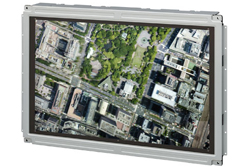Europe's online source of news, data & analysis for professionals involved in packaged media and new delivery technologies

Consumer electronics makers forge ahead with glasses-free 3D TV
The ink is barely dry on 3D active shutter glasses technology that the same companies behind it are already announcing glasses-free 3D TV products. In what is likely to be a world first, Toshiba is planning to release before the end of 2010 a TV set that will enable viewers to see 3 D images without the need for 3D glasses, according to Japanese newspaper Yomiuri Shimbun. Sony has joined the race.
Toshiba says it has developed a 21-inch LCD HDTV set – the Toshiba Mobile Display (pictured) – that offers 3D without the need for 3D glasses. The so-called auto-stereoscopic set supports a resolution of 1280 x 800 pixels, 480 nits brightness, and a 30-degree horizontal viewing angle. Whereas current 3D TVs split the picture into a right-eye image then a left-eye image to be watched with active shutter glasses, the Toshiba display breaks the picture into nine images.
According to experts at myce.com, the limited 30 degree viewing angle is because the Toshiba screen uses a multi-parallax design that has been implemented on smaller screens. The technology is very similar to what Nintendo is doing with the 3DS, except that Nintendo’s console is only using single parallax because only one person needs to see the 3D effect, says myce.com.
Toshiba is not alone in their pursuit of glasses-free 3D. LG is pursuing the Holy Grail as is Philips that has already shown off a TV using lenticular technology to produce depth in images without the need for glasses. Engadget China has shown the first images of Fuzhou Rockchip’s new glasses-less 3D media player. Due to be shown at, the Supernova x1 is rumoured to use a lenticular display as well to display its 3D content.
Sony is joining the race. "Seeing 3D without glasses is more convenient," Sony senior vice president Yoshihisa Ishida is quoted at saying at the Tokyo headquarters. "We must take account of pricing before we can think about when to start offering them."
A view echoed by Maarten Tobias, CEO of Dimenco, a venture founded by four former Philips people and which is now handling Philips' glasses-free 3D TV development work. Tobia does not reckon any vendor will have a product out before 2013. He told website Broadcast TV News it will be "three to five years" before glasses-free 3D TVs will be released commercially. So, that prediction puts the debut of such screens sometime between 2013 and 2015.
Singapore-based auto-stereoscopic technology developer Sunny Ocean Studios (see separate story) has been demonstrating glasses-free 3D TV prototypes.
The auto-stereoscopic technology is already used for some store displays. Viewers are to stand in specific spots for the 3D effect to emerge, and the image quality is much lower than that of screens using glasses.
Story filed 04.09.10




















